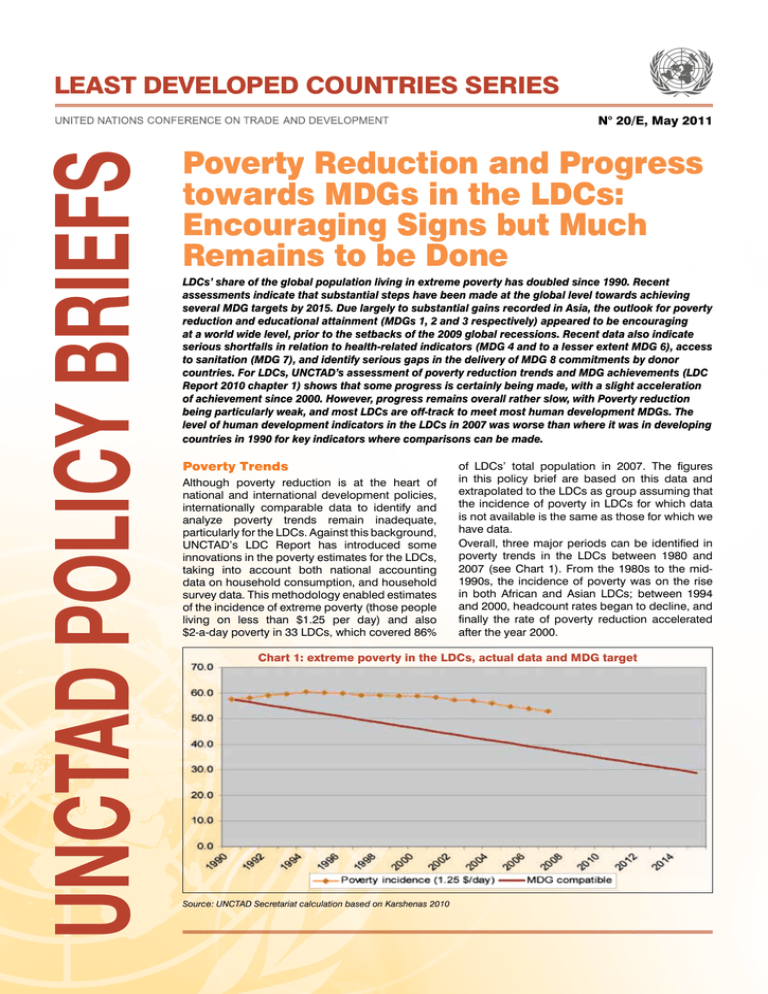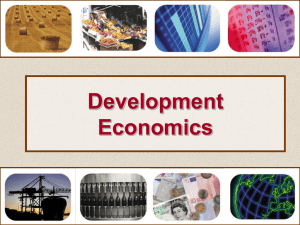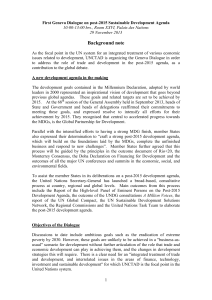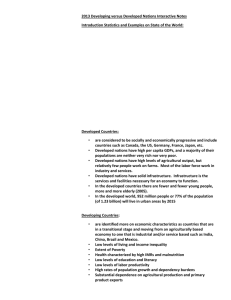Poverty Reduction and Progress towards MDGs in the LDCs:
advertisement

Least developeD countries SERIES UNCTAD POLICY BRIEFS N° 20/E, May 2011 Poverty Reduction and Progress towards MDGs in the LDCs: Encouraging Signs but Much Remains to be Done LDCs’ share of the global population living in extreme poverty has doubled since 1990. Recent assessments indicate that substantial steps have been made at the global level towards achieving several MDG targets by 2015. Due largely to substantial gains recorded in Asia, the outlook for poverty reduction and educational attainment (MDGs 1, 2 and 3 respectively) appeared to be encouraging at a world wide level, prior to the setbacks of the 2009 global recessions. Recent data also indicate serious shortfalls in relation to health-related indicators (MDG 4 and to a lesser extent MDG 6), access to sanitation (MDG 7), and identify serious gaps in the delivery of MDG 8 commitments by donor countries. For LDCs, UNCTAD’s assessment of poverty reduction trends and MDG achievements (LDC Report 2010 chapter 1) shows that some progress is certainly being made, with a slight acceleration of achievement since 2000. However, progress remains overall rather slow, with Poverty reduction being particularly weak, and most LDCs are off-track to meet most human development MDGs. The level of human development indicators in the LDCs in 2007 was worse than where it was in developing countries in 1990 for key indicators where comparisons can be made. Poverty Trends Although poverty reduction is at the heart of national and international development policies, internationally comparable data to identify and analyze poverty trends remain inadequate, particularly for the LDCs. Against this background, UNCTAD’s LDC Report has introduced some innovations in the poverty estimates for the LDCs, taking into account both national accounting data on household consumption, and household survey data. This methodology enabled estimates of the incidence of extreme poverty (those people living on less than $1.25 per day) and also $2-a-day poverty in 33 LDCs, which covered 86% of LDCs’ total population in 2007. The figures in this policy brief are based on this data and extrapolated to the LDCs as group assuming that the incidence of poverty in LDCs for which data is not available is the same as those for which we have data. Overall, three major periods can be identified in poverty trends in the LDCs between 1980 and 2007 (see Chart 1). From the 1980s to the mid1990s, the incidence of poverty was on the rise in both African and Asian LDCs; between 1994 and 2000, headcount rates began to decline, and finally the rate of poverty reduction accelerated after the year 2000. Chart 1: extreme poverty in the LDCs, actual data and MDG target Source: UNCTAD Secretariat calculation based on Karshenas 2010 The main feature of poverty in LDCs is its all-pervasive and persistent nature: in 2007, 53% of the population was living on less than $1.25 a day, and 78% on less than $2 a day. This implies that 421 million people were living in extreme poverty in LDCs that year (see Table 1). The incidence of extreme poverty was significantly higher in African LDCs, at 59%, than in Asian LDCs, at 41%. For the $2/day poverty line, however, the difference was less marked: 80% in African LDCs and 72 per cent in Asian LDCs. developing countries as a group, the LDCs remain off-target to reduce poverty by half between 1990 and 2015. Moreover, since the LDC population is young and increasing rapidly, the number of people living in extreme poverty continued to rise even during the boom, despite the decline in headcount rates. As a consequence, given the continuation of trends since 2000 and ignoring any possible impact of the crisis, the number of extreme poor living in LDCs by 2015 will be 439 million, whilst if the MDG target were achieved it would be only 255 million. Table 1: Poverty in the LDCs, selected years LDCs as a Global Locus of Extreme Poverty 1.25 $/ day poverty line Incidence 2 $/day poverty line Millions of poor Incidence Millions of poor 1990 57.6% 301.9 82.5% 432.2 2000 58.9% 398.6 81.3% 550.0 2007 52.8% 421.4 77.5% 618.7 Source: UNCTAD Secretariat calculation based on Karshenas 2010 Notwithstanding rapid economic growth during the 2000s, the pace of poverty reduction in the LDCs has been quite modest, especially with respect to MDG targets. In contrast to Using the Karshenas database, it is also possible to estimate the share of the global population of people living in extreme poverty in LDCs (see chart 2). What is apparent is that in 2007 China and India together were the main locus of extreme poverty, accounting for 42% of the people living in extreme poverty in all developing countries. 36% of extreme poor people resided, on the other hand, in the LDCs, and 22% in other developing countries (excluding China and India). Given current trends in poverty reduction, as well as population dynamics, it is clear that over time LDCs will become the major locus of extreme poverty in the world. In 1990, only 18% of the extreme poor lived in LDCs, while in 2000 the share was 27%. What will be the share in 2020? Chart 2: Share of people living in extreme poverty (below 1.25 $/day) in developing countries Source: UNCTAD Secretariat calculation based on Karshenas database Estimating global poverty is, of course, fraught with difficulty. World Bank estimates of poverty in the LDCs are slightly higher than those of the Karshenas database in both 1990 and 2007. But Karshenas’ estimates of poverty in other developing countries are also lower and his estimates of extreme poverty in India diverge significantly from World Bank data. In any case, even using the World Bank data the overall trend remains the same: the share of the global population living in extreme poverty which is located in LDCs increased from 18% in 1990 to 30% in 2005. Taking these two estimates together, we can suggest that at least one-third of the world population living in extreme poverty now lives in LDCs and this is up from less than onefifth in 1990. What will be the share in 2015? What will be the share at the end of the Istanbul Programme of Action in 2021? Human Development Trends Moving from income poverty to undernourishment, the data also indicate that progress has been slow. About 34% of the LDC population is reported to have been undernourished in 2005–2007, compared with 16% in developing countries. Since then, some reversals in the progress against hunger have inevitably taken place, as a consequence of the food price hikes in mid 2008, and the fallout of the global crisis in 2009. Turning to the other MDG indicators, the level of human development in the LDCs appears appallingly low, comparable to that of developing countries in 1990 (see Table 2). In terms of progress towards specific time-bound MDG targets, the following trends are clear: • Regarding the target for universal primary education, both LDCs and developing countries are only slightly off track owing to a significant acceleration of enrolments since 2000. However, only 59% of children in LDCs who start grade 1 reach the last grade of primary school, compared with 87% in developing countries. • Concerning access to safe water, developing countries are on track to achieve the goal, but LDCs as a group are off track. There has been no significant change in the trend of increasing access to improved water sources in LDCs since 2000. • Both developing countries and LDCs are off track in the rate of progress towards the target of reducing infant mortality and child mortality by two thirds between 1990 and 2015, though the rate is actually faster in LDCs than in developing countries. However, because the former started from a very high level of mortality rates, overall they will fall far shorter of the target by 2015. There is no sign that there has been an acceleration of progress since 2000. •R egarding access to improved sanitation facilities, both developing countries and LDCs are off track, but the rate of progress in LDCs is slower, with no significant acceleration since 2000. • Regarding the maternal mortality rate, both LDCs and developing countries have shown painfully slow progress. Table 2: comparison between LDCs and developing countries for selected MDG indicators Selected MDG Indicators Units LDCs 1990 DCs 2007 or latest data 1990 2007 or latest data Extreme poverty (World Bank) percent 63.3 53.4 45.7 26.6 Extreme poverty (UNCTAD) percent 57.5 52.7 40.6 21.9 Undernourishment percent 40 32 20 16 Primary school enrolment percent 52.3 78.8 79.9 88.8 Under-5 mortality rate per 1000 live births 179.8 128.9 100.0 72.0 Infant mortality rate per 1000 live births 112.3 82.4 68 49 per 100’000 live births 900 870 480 450 Access to water (share of population without) percent 46 38 29 16 Access to sanitation percent 76 64 59 48 Maternal mortality rate Source: UNCTAD Secretariat calculation based on MDG 2010, Statistical Annex and Karshenas 2010 A more disaggregated picture (see Chart 3) shows that only a handful of countries are on track to achieve the MDGs on a broad front. Considering seven indicators for which sufficient data are available, it is apparent that: • The most significant progress has been made towards the net primary school enrolment target, where half of the LDCs are on track. • About one third of LDCs are on track to meet the goal of halving the proportion of people without access to safe drinking water. • Only one quarter of the LDCs are on track to reach the target of reducing infant mortality by two thirds between 1990 and 2015, and a similar proportion are on track to achieve the child mortality target. • The slowest progress is in relation to the poverty reduction target, where the new estimates indicate that only 4 out of 33 LDCs for which data were available are on track to halve the incidence of extreme poverty between 1990 and 2015. • The data also suggest that significant progress has been made in reducing the incidence of undernourishment by half. However, the pattern varies among LDCs: half of them appear to be on track to achieve the target while in more than a third progress has either stagnated or been reversed. The slow progress in reducing malnutrition in LDCs as a group compared with the comparatively good disaggregated performance is because there are many small countries, particularly small island developing States (SIDS) that have made good progress on this indicator. Chart 3: Number of LDCs progressing or regressing on selected MDG indicators Source: UNCTAD Secretariat calculation based on MDG 2010, Statistical Annex UNCTAD To be more precise, only seven LDCs are on track to achieve four or more of the above targets: Ethiopia, the Lao People’s Democratic Republic, Malawi, Maldives, Mozambique, Nepal and Samoa. Overall, these data indicate that the acceleration of growth during the period of economic boom in the LDCs led to some advances in the progress towards MDGs and poverty reduction since 2000. However, only a handful of countries are on track to achieve the MDGs on a broad front. There has been significant progress in net primary enrolment and gender parity in primary education, reflecting strong Government and donor commitment. Poverty eradication has also advanced to some extent. However these achievements are rather modest in relation to policy targets. Most notably, LDCs’ growth acceleration in the early and mid-2000s appears to have had little impact on employment creation and overcoming food insecurity. Finally, in the crucial areas of quality and outreach of health services (MDGs 4 and 5) progress has been sluggish, as also for major infrastructural investments, such as in improving sanitation. Impact of the Crisis Though LDCs appear to have weathered the global economic crisis better than initially feared, the social costs of the downturn exacerbated the hardships already created in 2008 by the hikes in food and fuel prices. Moreover, the adverse social consequences of the crisis are likely to be long-lasting regardless of any rebound in macroeconomic variables, because many of the coping strategies used by poor people in the trough of the downturn (such as selling assets or taking children out of school) tend to have consequences for lifetime wellbeing. Social costs will then ultimately depend on the speed and strength of the global recovery. In view of these factors some suggest that the downturn may have resulted in an additional 9.5 million people living in extreme poverty in LDCs. Policy Implications Second, there is a need to reconnect the MDGs to a holistic economic development strategy. In the context of mass poverty, a narrow focus on sound economic fundamentals, improving the overall investment climate and targeted safety nets has proved not to be effective enough, in spite of the massive increase of exports and FDI. A more growth-oriented macroeconomic policy together with a developmental agricultural policy and developmental industrial policy are also needed to spur the development of productive capacities and associated expansion of productive employment, as well as reduce commodity dependence. Third, with a view to reducing LDCs aid dependence over the long term, it is clear that even the present MDG achievements will not be sustainable unless greater attention is devoted to the mobilization of their domestic resources. This in turn requires building up the fiscal base of their economies, as well as scaling up the support to their productive sectors allowing a sustained development of their productive capacities. While specific policies to mobilize domestic resources need to be assessed on a country-by-country basis, there is clear scope to improve the efficiency of LDCs’ revenue collection systems, to broaden the tax base and to strengthen the contractual position of LDC authorities in mineral rent negotiations. Fourth, it is clear that the largest share of people living in extreme poverty in the developing countries is actually located in China and India. The other developing countries have a smaller share of the total extremely poor than the LDCs but this does not mean that they have no poverty problem. The international $1-a-day poverty line was originally devised because it was representative of the national poverty lines of the poorest countries. There are millions living on less than $2-a-day, $3-a-day and $4-a-day in other developing countries, which is far below the poverty line of rich countries. Improving the human welfare of these people also matters. Moreover, LDCs will only move up the development ladder if the more advanced developing countries can also move up. Tackling the global poverty problem requires an approach which deals with the specific problems of LDCs but does not ignore other developing countries. unctad/press/PB/2011/8 It must be recognized that given that several MDG targets are defined in relative terms (for example halving the proportion of people whose income is less than 1$ a day) poorer countries with worse starting points are actually confronted with more ambitious objectives. Nonetheless, it is evident that in spite of some progress, much more must be done now in LDCs to reach the targets. As both LDC Watch and Wolfenshohn have put it, there can be no successful achievement of the MDGs without the LDCs. The reduction of income poverty has been particularly weak given the strength of the GDP boom. The experience of the 2000s suggests four major policy lessons. First, and foremost, whilst economic growth is a key driver of poverty reduction and human development, not all patterns of growth are equal. In most LDCs, the boom typically was related to the expansion of extractive industries (and in few cases services) but largely by-passed agriculture, the sector which currently employs most people, as well as manufacturing, the sector with the greatest potential of increasing returns. Particularly in African LDCs, this lopsided pattern of structural change gave rise to major deficits in creating productive jobs and livelihoods in relation to expanding labour force. Prolonged agricultural stagnation, coupled with the limited effects of growth in terms of offfarm employment creation, largely explain why the economic boom did not translate into poverty reduction and progress in achieving the human development MDGs. + 4 1 2 2 9 1 7 5 8 2 8 – u n c t a d p r e s s @ u n c t a d . o r g – w w w . u n c t a d . o r g







